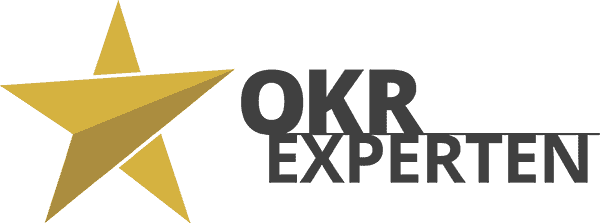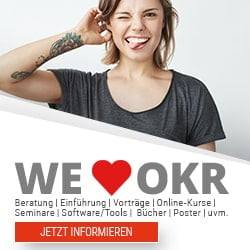
29 May PPP Progress, Plans and Problems – OKR Reviews
OKR Reviews with the Progress, Plans and Problems method (PPP)
Regardless of how large or small your company or project is, managers need a reliable method that allows them to synchronize their teams and ensure dynamism and productivity. TheProgress,Plans andProblems(PPP) framework is an effective method of status management that perfectly complements OKRs. Many successful companies, including Apple, Facebook and Skype, are already using them. This simple but powerful framework lets teams and team members answer three questions:
The PPP report
- Progress made in the past period(What has been done?)
- The plans(What is to be done?) for the next period, and
- The problems foreseen by each employee or team(What are the obstacles?)
This way of thinking simplifies and rationalizes status reports enormously.
With the help of PPP, managers can keep their team’s short and long-term OKRs under control without disrupting productivity through excessive meetings or creating unnecessary stress among employees. PPP focuses on specific, actionable OKRs that are unique to each team or individual.
Managers can use the PPP framework as a tool for recognizing the strengths and weaknesses of their employees. If an employee has repeated success in one area while repeatedly reporting difficulties in another, an attentive manager should capitalize on these strengths while minimizing contact with weaknesses. The ability to assign each team member the roles for which they are best suited increases the focus, motivation and productivity of your employees.
PPP is therefore an ideal method of reporting for all companies, as all team members can concentrate on their individual, manageable tasks. PPP on OKRs keeps the entire team on the same page, while helping individual team members set better, realistic goals and stay on task.
What is PPP?
As already mentioned, the framework for progress, plans and problems is a simple management technique for structuring status reporting and making it consistent. Three questions are answered (see above).
In the weekly OKR Check-In, all members also report their three points for each PPP category. The manager or team lead then aggregates and analyzes the answers and can thus address problems early on before they become insurmountable.
Why exactly three? Three is the most convincing number in communication. The rule of 3 applies everywhere – in writing, economics, business, psychology, math, computer programming, religion and science. Science suggests that people perceive and remember groups of three more easily because three is the lowest number required for pattern recognition. Adhering to the rule of 3 also ensures that the working memory is never overloaded, which leads to better retention and long-term memory.
These status reports should be short, concise and informal. In a world without much time, long sections of text are often skimmed over or ignored. One positive example is the popularity of Twitter. Here, people are served information in small bites. Everyone has time to read 140 characters or less. This methodology can easily be transferred to status updates and progress reports.
Progress
- What have you achieved this week?
- Progress includes achievements and completed or completed tasks
- Asking about progress invites employees to reflect on the things they have done, rather than constantly focusing on what still needs to be achieved
Plan
- What are you focusing on in the coming week?
- Plans are what you are trying to achieve according to your OKRs for the next period
- By paying close attention to the plan, managers can identify where it does not align with the relevant OKRs and prioritize the most important tasks
Problems
- Are you stuck? Can anyone help?
- Problems prevent tasks from being completed and may need help from someone
- Problems require immediate support and attention to prevent one person’s difficulties from derailing the schedule of the entire project.
How does PPP improve effectiveness?
The PPP method logs all progress
By recording everything in writing, the teams avoid unnecessary misunderstandings. A manager can refer to PPP archives at any time. This enables them to assess progress, offer help to anyone experiencing difficulties and distribute tasks effectively.
PPP is cost-efficient
The PPP method allows managers to keep their finger on the pulse of their project, rather than paying each employee to attend a lengthy or irrelevant meeting.
PPP is fast
Filling out the PPP template only takes a few minutes and sending it only takes a few moments. Your ROI in relation to the time required is therefore enormous.
PPP is simple
Each status update contains the answers to the same three questions. These reports are informal, brief and specific.
PPP improves responsibilities
Team members are more likely to achieve their goals when they share their goals with colleagues because they know that someone is relying on them.
PPP connects the manager with the team and the team with the manager
Regular progress reports keep communication going and make performance expectations clear. Teams no longer waste time with ineffective, irregular and inefficient meetings.
PPP improves transparency
As all team members report regularly on their work, managers can react to potential problems at an early stage. Employees address them openly and can work on them together before they get out of hand. Everyone should be aware of what everyone else is working on. Ideally, a manager should present their own PPP report to the team to create transparency in both directions.
PPP improves commitment
PPP involves small, practicable steps. This reduces the likelihood of your team members being overwhelmed. As soon as the manager has approved the specific goals for the week, all employees know what they can refer to.
Tips for introducing PPP
- Keep it short. Stick to the rule of 3.
- Keep them regular and make them a requirement because consistency is key to habit formation.
- Some people find the idea of highlighting their problems difficult. It is easy to categorize problems as personal failures. Instead, focus on how they can use problems for collaboration and team building. A positive error culture is the key here.
- Record the reports in writing. This way you can refer to them later. Also, before meetings, make sure everyone has read the whole team’s progress reports. This way you avoid spending time simply repeating information.
- Follow-up. Every report submitted is an opportunity to start a conversation. So instead of just focusing on what hasn’t been done, offer your help and recognize the work of your team.
Summary
The Progress, Plans and Problems framework is a proven project management technique that is both simple and powerful. Many managers and teams already use it to report progress to companies, customers or CEOs and board members simply and effectively.
We hope that this article has given you an insight into our daily work with Objectives and Key Results. You can find many more articles on this topic in our OKR Expert Magazine. Are you planning to introduce Objectives and Key Results in your company? We will be happy to advise you!







